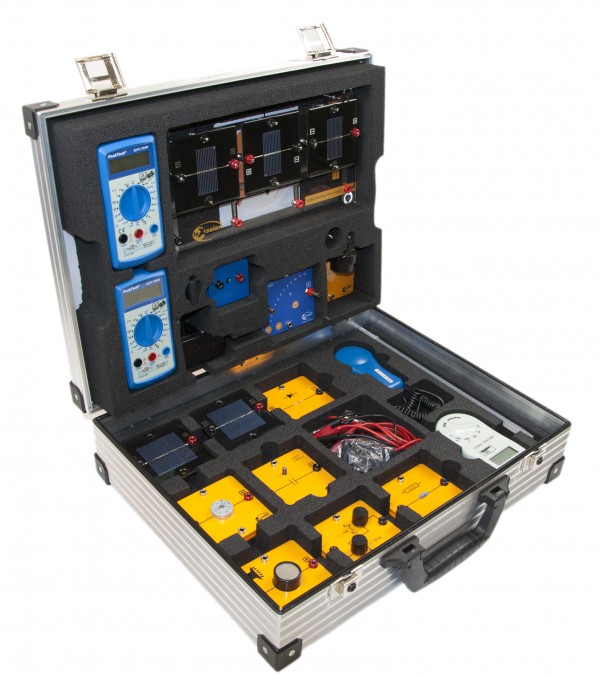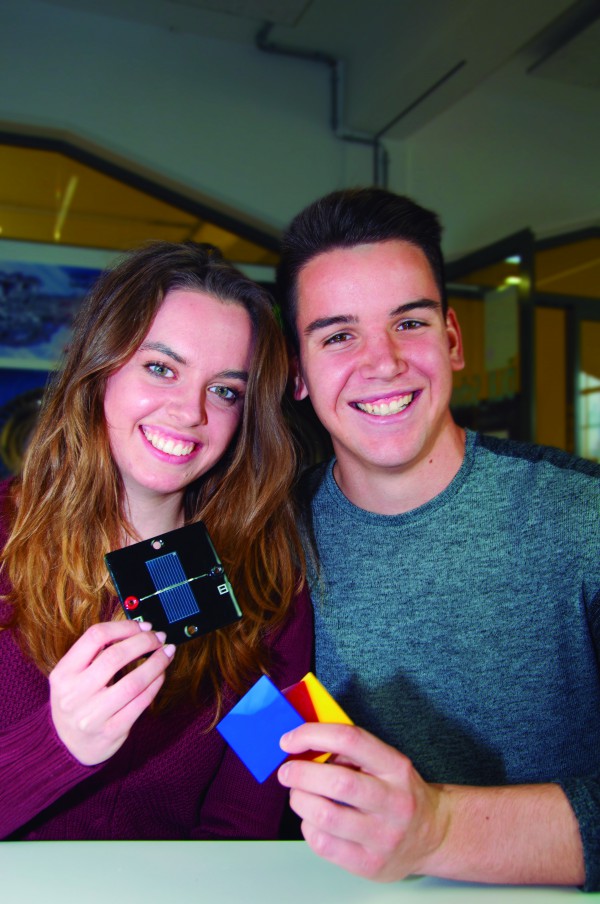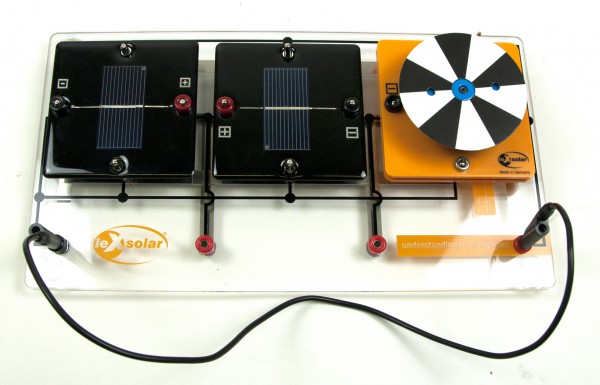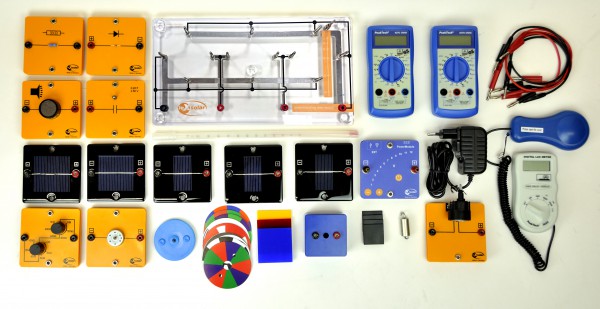Description
The name says it all: this fully equipped experiment system can be
used wherever you are without further components. This kit already
includes all necessary ancillary equipment, like measuring equipment, and is delivered in an aluminum case with heavy-duty foam inserts. The scope of experiments ranges from simple trials that
show the basic characteristics of the solar energy, to more challenging experiments dealing with topics like IV characteristics or temperature dependency of solar cells.
Because of the large range of potential experiments, the product is
also suitable for internal workshops in companies as well as a demonstration kit for sales representatives.
used wherever you are without further components. This kit already
includes all necessary ancillary equipment, like measuring equipment, and is delivered in an aluminum case with heavy-duty foam inserts. The scope of experiments ranges from simple trials that
show the basic characteristics of the solar energy, to more challenging experiments dealing with topics like IV characteristics or temperature dependency of solar cells.
Because of the large range of potential experiments, the product is
also suitable for internal workshops in companies as well as a demonstration kit for sales representatives.
Components
3x 1100-01 Solar module 0.5 V, 420 mA
1x 1100-02 Solar module 0.5 V, 840 mA
1x 1100-19 leXsolar-Base unit Large
1x 1100-20 Lighting module
1x 1100-21 Diode module
1x 1100-22 Resistor module
1x 1100-23 Potentiometer module
1x 1100-24 Gear motor module
1x 1100-25 Buzzer module
1x 1100-07 Solar module 1.5 V, 280 mA
1x 1100-27 Motor Module without Gear
1x 1100-28 Color discs - Set 1
1x 1100-29 Solar cell cover set (4 pieces)
1x 1100-30 Color filters
1x 1400-07 Capacitor module 220 mF, 2.5V
1x 9100-05 PowerModule
1x L2-05-024 Hook weight 20g
2x L2-06-011 Digital multimeter
1x L2-06-012 Test lead black 25 cm
1x L2-06-013 Test lead red 25 cm
1x L2-06-016 Laboratory thermometer
1x L3-01-009 Aluminium case PV Rtg 1105
1x L3-03-258 Info sheet initial startup
1x L3-01-047 Insert PV-Ready to go
1x L3-03-130 Layout diagram 1105 PV Ready-to-go
2x L2-06-014 Test lead black 50 cm
2x L2-06-015 Test lead red 50 cm
1x L2-06-034 Luxmeter
Zusätzlich empfohlene Teile:
L3-03-160 Lehrerheft leXsolar-PV Ready-to-go
L3-03-034 Anleitungsheft leXsolar-PV Ready-to-go
L3-03-035 Instructions manual leXsolar-PV Ready-to-go
L3-03-263 Teacher`s manual leXsolar-PV Ready-to-go
1x 1100-02 Solar module 0.5 V, 840 mA
1x 1100-19 leXsolar-Base unit Large
1x 1100-20 Lighting module
1x 1100-21 Diode module
1x 1100-22 Resistor module
1x 1100-23 Potentiometer module
1x 1100-24 Gear motor module
1x 1100-25 Buzzer module
1x 1100-07 Solar module 1.5 V, 280 mA
1x 1100-27 Motor Module without Gear
1x 1100-28 Color discs - Set 1
1x 1100-29 Solar cell cover set (4 pieces)
1x 1100-30 Color filters
1x 1400-07 Capacitor module 220 mF, 2.5V
1x 9100-05 PowerModule
1x L2-05-024 Hook weight 20g
2x L2-06-011 Digital multimeter
1x L2-06-012 Test lead black 25 cm
1x L2-06-013 Test lead red 25 cm
1x L2-06-016 Laboratory thermometer
1x L3-01-009 Aluminium case PV Rtg 1105
1x L3-03-258 Info sheet initial startup
1x L3-01-047 Insert PV-Ready to go
1x L3-03-130 Layout diagram 1105 PV Ready-to-go
2x L2-06-014 Test lead black 50 cm
2x L2-06-015 Test lead red 50 cm
1x L2-06-034 Luxmeter
Zusätzlich empfohlene Teile:
L3-03-034 Anleitungsheft leXsolar-PV Ready-to-go
L3-03-035 Instructions manual leXsolar-PV Ready-to-go
L3-03-263 Teacher`s manual leXsolar-PV Ready-to-go
Experiments
1. Understanding the leXsolar base unit
2. Optical illusions
2.1 The basic setup for experiments with the color disks
2.2 Color qualities
2.3 Additive color mixing
2.4 Optical illusions with the Benham-disk
2.5 Optical illusions with the relief-disk
3. Experiments about different kinds of radiation
3.1 The influence of diffuse radiation on solar cell power (qualitative)
3.2 The influence of direct radiation on solar cell power (qualitative)
3.3 The intensity of albedo-radiation of different substances (qualitative)
4. Dependence of solar cell power on its area
5. Dependence of solar cell power on angle of incidence of light
5.1 Dependence of solar cell power on angle of incidence of light (qualitative)
5.2 Dependence of solar cell power on angle of incidence of light (quantitative)
6. Dependence of solar cell power on illuminance
6.1 Dependence of solar cell power on illuminance 1 (qualitative)
6.2 Dependence of solar cell power on illuminance 2 (qualitative)
6.3 Dependence of solar cell power on illuminance 1 (quantitative)
7. Dependence of solar cell power on temperature
8. Dependence of solar cell power on frequency of incident light
9. The diode character of a solar cell
9.1 The dark characteristics of a solar cell
9.2 The internal resistance of a solar cell depending on reverse or forward biasing or in the dark or under illumination
10. The I-V-characteristics of a solar cell
10.1 Dependence of solar cell power on load
10.2 The I-V-characteristics and filling factor of a solar cell
10.3 Dependence of I-V-characteristics of a solar cell on illuminance
11. Behavior of voltage and current in series and parallel connections of solar cells
11.1 Behavior of voltage and current in series and parallel connections of solar cells (qualitative)
11.2 Behavior of voltage and current in series and parallel connections of solar cells (quantitative)
12. Behavior of voltage and current of series and parallel connection of solar cells depending on shading
12.1 Behavior of voltage and current of a series connection of solar cells depending on shading (qualitative)
12.2 Behavior of voltage and current of a series connection of solar cells depending on shading (quantitative)
12.3 Behavior of voltage and current of a parallel connection of solar cells depending on shading (quantitative)
13. Simulation of a stand-alone grid with photovoltaic station
14. Characteristic graphs of a capacitor
14.1 Characteristic graphs of a capacitor charged by a solar cell
14.2 Discharging process of a capacitor
15. Practical experiments
15.1 Determination of efficiency of some energy conversions
15.2 Rotational direction and speed of a motor
15.3 Starting and running current of a motor
2. Optical illusions
2.1 The basic setup for experiments with the color disks
2.2 Color qualities
2.3 Additive color mixing
2.4 Optical illusions with the Benham-disk
2.5 Optical illusions with the relief-disk
3. Experiments about different kinds of radiation
3.1 The influence of diffuse radiation on solar cell power (qualitative)
3.2 The influence of direct radiation on solar cell power (qualitative)
3.3 The intensity of albedo-radiation of different substances (qualitative)
4. Dependence of solar cell power on its area
5. Dependence of solar cell power on angle of incidence of light
5.1 Dependence of solar cell power on angle of incidence of light (qualitative)
5.2 Dependence of solar cell power on angle of incidence of light (quantitative)
6. Dependence of solar cell power on illuminance
6.1 Dependence of solar cell power on illuminance 1 (qualitative)
6.2 Dependence of solar cell power on illuminance 2 (qualitative)
6.3 Dependence of solar cell power on illuminance 1 (quantitative)
7. Dependence of solar cell power on temperature
8. Dependence of solar cell power on frequency of incident light
9. The diode character of a solar cell
9.1 The dark characteristics of a solar cell
9.2 The internal resistance of a solar cell depending on reverse or forward biasing or in the dark or under illumination
10. The I-V-characteristics of a solar cell
10.1 Dependence of solar cell power on load
10.2 The I-V-characteristics and filling factor of a solar cell
10.3 Dependence of I-V-characteristics of a solar cell on illuminance
11. Behavior of voltage and current in series and parallel connections of solar cells
11.1 Behavior of voltage and current in series and parallel connections of solar cells (qualitative)
11.2 Behavior of voltage and current in series and parallel connections of solar cells (quantitative)
12. Behavior of voltage and current of series and parallel connection of solar cells depending on shading
12.1 Behavior of voltage and current of a series connection of solar cells depending on shading (qualitative)
12.2 Behavior of voltage and current of a series connection of solar cells depending on shading (quantitative)
12.3 Behavior of voltage and current of a parallel connection of solar cells depending on shading (quantitative)
13. Simulation of a stand-alone grid with photovoltaic station
14. Characteristic graphs of a capacitor
14.1 Characteristic graphs of a capacitor charged by a solar cell
14.2 Discharging process of a capacitor
15. Practical experiments
15.1 Determination of efficiency of some energy conversions
15.2 Rotational direction and speed of a motor
15.3 Starting and running current of a motor
Assembly Plan
Product Video
Sales are exclusively for entrepreneurs, business owners, freelancers, and public institutions. Please also refer to our terms and conditions as well as privacy policy.



